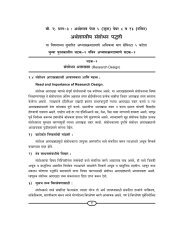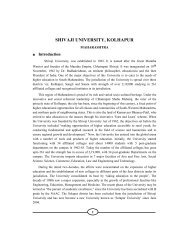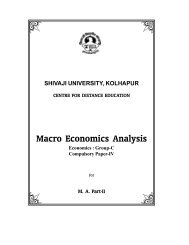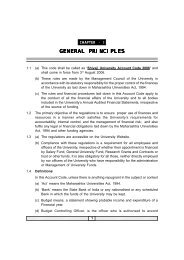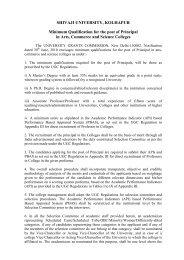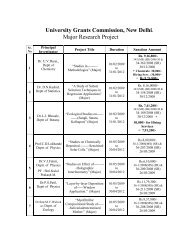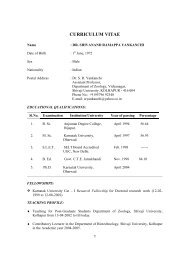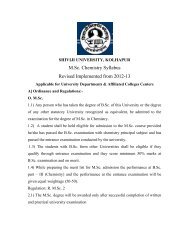Economics(Paper-4) - Shivaji University
Economics(Paper-4) - Shivaji University
Economics(Paper-4) - Shivaji University
Create successful ePaper yourself
Turn your PDF publications into a flip-book with our unique Google optimized e-Paper software.
Prof.R.Rodan has mentioned three kinds of indivisibilities, explained as under.<br />
1. Indivisibility in Production Function<br />
2. Indivisibility in Demand<br />
3. Indivisibility in Supply of Savings.<br />
1. Indivisibility in Production Function:<br />
Indivisibility in production function refers to the indivisibilities of input, output and<br />
production processes. These indivisibilities lead to increasing returns higher output,<br />
income, employment and lowering capital – output ratio. Rodan regards social overhead<br />
capital (power, transport, communication and housing, etc.) as important constituent<br />
of indivisibilities and external economies. The reason is that expansion of social<br />
overhead capital creates investment opportunities in various industries which help in<br />
rising the level of investment. Sustained economic development requires creation and<br />
expansion of social facilities, which requires large amount of investment called<br />
“lumpiness of capital”. Lumpiness of capital creates external economies which are the<br />
way of economic development.<br />
2. Indivisibility of Demand:<br />
For expansion of market demand indivisibility is more important. The small markets<br />
limit the investment opportunities and obstruct the development process. The indivisibility<br />
of demand requires simultaneous investment in various industries. Rodan cites the<br />
example of shoe factory to explain the point. Assuming a closed economy, let us suppose<br />
that hundred disguised unemployed workers (whose marginal productivity is zero) are<br />
employed in a shoe factory.Their wages would constitute additional income. If newly<br />
employed workers spend their entire income for the purchase of shoes they produce,<br />
the shoe factory will find a market. Considering workers have diverse demands and do<br />
not spend their entire additional income on shoes, and then shoe factory may face the<br />
problem of less demand for shoes and small market for its product. The small size of<br />
market would reduce the incentive to invest and the result would be the closure of the<br />
factory.This way the investment in a single project would fail to widen the size of market.<br />
Now suppose the thousand workers are employed in hundred industries and they<br />
produce consumer goods and newly employed workers spend their wages for the<br />
purchase of those goods. This would enlarge the extent of demand and the size of the<br />
market. Thus the indivisibility of demand necessarily implies a high quantum of<br />
investment in complementary industries for enlarging the size of market.<br />
3. Indivisibility in the Supply of Savings:<br />
We have discussed above that a large amount of investment is necessary for<br />
starting complementary industries. In underdeveloped countries the level of savings is<br />
low because of low level of national income. To generate savings it is imperative that a<br />
123456789012345678901234567890121234567<br />
123456789012345678901234567890121234567<br />
24<br />
123456789012345678901234567890121234567<br />
123456789012345678901234567890121234567<br />
123456789012345678901234567890121234567<br />
123456789012345678901234567890121234567<br />
123456789012345678901234567890121234567<br />
123456789012345678901234567890121234567




